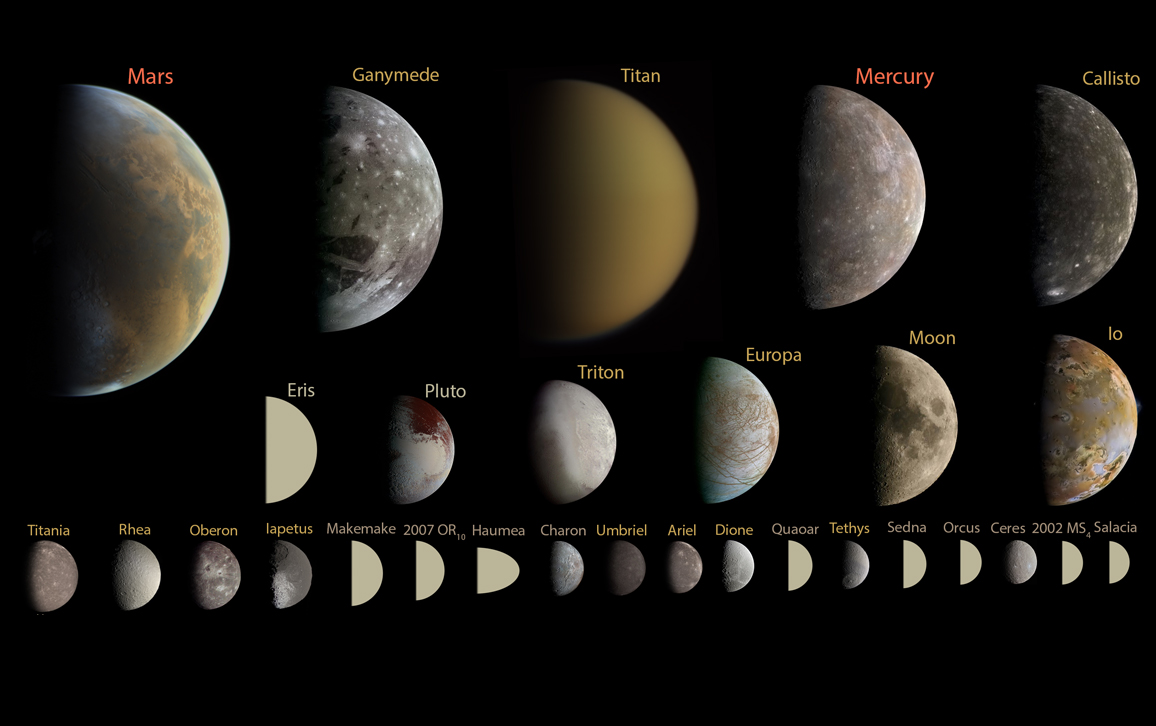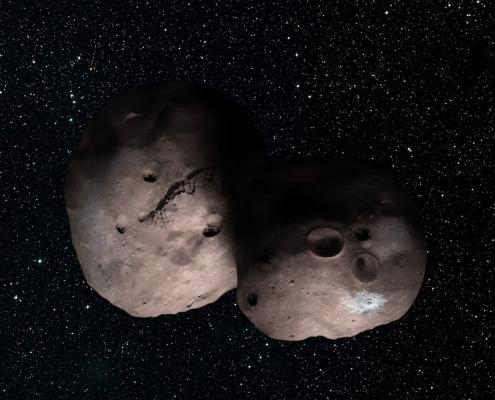By Light Alone: Mapping the Solar System's Past
By Michele Bannister
A major effort is under way to map the orbits of tiny worlds in the outer Solar System and study their surfaces through their colors.
A major effort is under way to map the orbits of tiny worlds in the outer Solar System and study their surfaces through their colors.

Mapping color across the populations of small worlds in the outer Solar System is helping to reveal how Neptune's past migration churned and disrupted their orbits—while, tantalizingly, perhaps leaving some entirely untouched. These tiny worlds are the size of cities or islands. Distant and faint, they reflect so little sunlight that even with our largest telescopes their varied surfaces of rock, ice, and carbon-rich molecules reduce down to points of light moving slowly across the sky. Fortunately, a trans-Neptunian world's color—how much light it reflects in different parts of the spectrum—can hint at the materials of its surface. The patterns of color seen across the filigree of the trans-Neptunian orbital populations contain clues about how the Solar System formed and mixed billions of years ago—and about how some worlds escaped and traveled from star to star.

Montage by Emily Lakdawalla. Data from NASA / JPL, JHUAPL/SwRI, SSI, and UCLA / MPS / DLR / IDA, processed by Gordan Ugarkovic, Ted Stryk, Bjorn Jonsson, Roman Tkachenko, and Emily Lakdawalla.
The birth of any planetary system is a place of fire and ice. Away from the fierce glow of the spinning young star, angular momentum forces the shrouding dust and gas of the star into a disk. Over time, the disk collapses and condenses into pebbles, still milky in the twists of their spinning disk, like a plate of bubble tea. The fury of the star drives off the last traces of gas. Dust and gas give way to a sea of tiny pearl-like proto-planets of ice and rock surrounding the star—among them the seeds of giant planets, which grow rapidly to dominate the system.
Like other planetary systems, the large planets of our Solar System have migrated: They orbit in different places today than where they formed (see “Sculpting Our Planetary System” by Sean Raymond in this issue). As the orbits of the planets adjusted, some swinging onto vast ellipses, many trillions of minor planets were cast asunder. A fraction, merely 5 trillion or so, were captured into our Oort cloud of comets, which sits about 20,000 to 50,000 times further from the Sun than our Earth orbits (at one astronomical unit, or au), where these minor planets are gently nudged by the tides of the galaxy.
Only one skyscraper-sized minor planet has yet been spotted as it came by from another star system. ‘Oumuamua flitted briefly by the Sun last year. We do not know its original star, and perhaps never will: It may have had its course shaped by previous encounters with other stars. ‘Oumuamua is far from alone. The formation of our planetary system sent some hundred trillion cousins of ‘Oumuamua to begin lonely wandering paths through the galaxy.
A major effort is under way to put together both the orbits found today for the tiny worlds, and the surfaces that they show as points of colored light.
Many hundreds of thousands of our primordial worlds were captured into complex, structured populations orbiting between and beyond the giant planets. About a fifth of the trans-Neptunian populations now orbit in resonance with Neptune. They occupy exactly the right point in the orbital dance, crossing Neptune’s orbit in complex overlapping patterns that are a little like the splay of a sunflower’s petals, but always avoiding the planet. It's a feat of celestial mechanics that preserves the resonant populations over billions of years. Scooped into the safety of the resonances, their present populations are a signature of how Neptune moved outward in the late stages of planetary migration, over some tens of millions of years.
The Outer Solar System Origins Survey (OSSOS) observed with the 3.6-meter Canada-France-Hawaii Telescope on Maunakea for the last five years, putting together the most comprehensive picture ever made of the orbits of distant worlds. The snapshot of today's system provided 840 carefully characterized orbits, identified from more than 37,000 hand-checked points of light, recorded from over 8,000 images.
This exquisite orbital map records both what is present and what is absent in the Solar System. Associated calibrations let the handfuls of discoveries in each resonance be scaled up to understand the true size of these orbital populations. Some groups number in the hundreds of thousands; for others, such as the icy planetesimals called Centaurs, only a few hundred presently dance between the giant planets, because only millions of years after their arrival, they are ejected from the Solar System.
A major effort is under way to put together both the orbits found today for the tiny worlds, and the surfaces that they show as points of colored light. For the brightest of the OSSOS discoveries, The Colours of OSSOS (Col-OSSOS) survey uses the Gemini North, Canada-France-Hawaii, and Subaru observatories to measure the brightness of reflected light with great precision in both visible light and in the near infrared. In visible light, the colors of the outer Solar System span a broad range, from neutral grayish like the Sun, to a rich red, darker than plums. There is a similar spread of colors in the infrared. These measurements are converted to a map of colors, between the visible and the near-infrared, or from about 300 to 1,300 nanometers in wavelength. The complete sample will reveal the intrinsic color structure of the outer Solar System. Col-OSSOS is nearing observation of 100 trans-Neptunian objects, turned from monochrome points of light into places. Each of these has an individual history, and together they lay out pathways for how the planets moved them into place.
It's a feat of celestial mechanics that preserves the resonant populations over billions of years.
Looking at the colors of the Kuiper belt shows that color relates to orbital population. In light recorded through particular filters at about 500, 600, and 900 nanometers, the various dynamically excited populations show a broad spread of colors from solar-neutral (sometimes called “blue”) through red. There is a unique surface of rich red colors for one population: the cold classicals. These Kuiper Belt objects orbit on round, flat orbits, often thought to have been unchanged since the dawn of the planetesimal disk. Knowing they have unique characteristics on their surfaces, we are now looking for such a surface elsewhere in the Kuiper belt, hunting for little worlds that started their lives in the disk and were nudged elsewhere by Neptune's gravity.
This picture slowly became more complex. One of the early discoveries by Col-OSSOS was that the cold classicals are sprinkled with a few blue-colored objects—but with a twist: All the blue cold classicals that we observed were binaries. They have colors akin to the neutral surfaces of dynamically excited trans-Neptunian objects. Our team explored dynamical simulations, which showed that these weakly bound blue binaries could have been very gently nudged outward a short distance of a few astronomical units into their current orbits, pushed out as Neptune smoothly migrated outward. Blue binaries are interlopers in the cold classical region, distinctive both in color and binarity.
Fortunately, the New Horizons spacecraft will fly within a few thousand kilometers of a smaller, London-sized cold classical, known as 2014 MU69, on New Year's Day 2019. This ability to compare between the mapping that we can do for dots of light from Earth and the sophisticated detail only possible from a spacecraft is incredibly exciting. Hopefully, New Horizons' observations can crack the mystery of which carbon-rich molecules give the cold classicals their color.

NASA/Johns Hopkins University Applied Physics Laboratory/Southwest Research Institute/Alex Parker
In October 2017, we were able to observe the interstellar object ʻOumuamua in the same wavelengths as we do in Col-OSSOS with the Gemini North telescope. Col-OSSOS provided a powerful context for interpreting the surface reflectance of this unique object. Remarkably, ʻOumuamua is within the range of surface reflectivity seen in the outer Solar System. This tiny world has traveled so far, and yet looks like the worlds in our own system! It seems that the processes that form and change planetary systems are indeed common between stars. When the next one of these interstellar objects is seen—perhaps from the upcoming Large Synoptic Survey Telescope, which is predicted to see as many as one interstellar object per year—it too can be observed and compared to the color map we are creating.
We may never know the exact history of our Solar System. The dynamical models that give us histories of Neptune's migration to test against the observed Kuiper Belt and beyond are subject to chaos. We cannot see a unique past, only a host of most probable paths. With studies like OSSOS and Col-OSSOS, the wide range of ways that our history could have unfolded is narrowing toward a Neptune that moved as steadily and smoothly as an ocean liner, buffeted by the tiny tugs of gravity from the dwarf planets in the disk.
Click "American Scientist" to access home page
American Scientist Comments and Discussion
To discuss our articles or comment on them, please share them and tag American Scientist on social media platforms. Here are links to our profiles on Twitter, Facebook, and LinkedIn.
If we re-share your post, we will moderate comments/discussion following our comments policy.